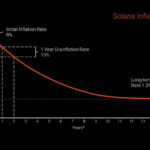In a surprising turn of events, Solana’s ambitious proposal to reform its inflation model has been rejected, leaving its high staking rewards intact for now. The contentious vote on Thursday aimed to overhaul the blockchain network’s existing inflation mechanics, which currently allow for generous annual staking rewards of 4.7%. Advocates of the reform, known as SIMD-0288, argued that reducing these rewards to as low as 1% would ultimately benefit the price of Solana’s native token, SOL. However, this effort fell short of the supermajority needed for implementation.
“Many people feel like SIMD-0228 is not the best proposal to address inflation on Solana,” said one validator operator, highlighting the concerns that swayed the vote.
The election showcased a deep divide within the Solana community, drawing significant attention and debate from its roughly 1,300 validators. While influential leaders and larger stakeholders supported the proposed changes, smaller validators rallied against them, fearing a significant cut to their income. This lively atmosphere was reminiscent of an election night in the U.S., filled with passionate discourse and dramatic vote counts that ultimately revealed a stark contrast in priorities among stakeholders.
With a remarkable turnout that saw over 66% of validators casting votes, the decision underscored a significant mobilization from those with smaller stakes who overwhelmingly opposed the proposal. In fact, data indicated that more than 60% of validators holding 500,000 SOL or less voted against the change, while their larger counterparts showed a majority in favor.
“The lopsided results suggest opponents’ warnings of economic ruin struck a nerve with small-time validators,” commented analysts interpreting the voting dynamics.
Advocates for SIMD-0288 believed their proposal would address ongoing inflation concerns within the network, arguing that a reduced inflation rate would potentially decrease the number of SOL tokens available for sale, thus supporting the token’s value. However, opponents cautioned that the plan was too rushed and could disrupt Solana’s decentralized finance (DeFi) ecosystem, particularly for those who rely on stable staking rewards. The debate continues as the community reflects on the implications of this vote, which stands as the first significant economic reform effort in Solana’s history to fail.

Solana’s High Staking Rewards and the Failed SIMD-0228 Reform
Key points from the article regarding Solana’s blockchain network and the recent voting on potential economic reforms:
- Failed Proposal: The SIMD-0228 proposal to reform Solana’s inflation system did not achieve the necessary supermajority for approval.
- Current Staking Rewards: Solana offers high annual staking rewards of 4.7%, which were at risk of being reduced to 1% or less under the proposed changes.
- Voter Turnout: The voting saw over 66% of Solana validators participate, indicating significant engagement in the decision-making process.
- Voting Divide: Smaller validators (those with less than 500,000 SOL) largely opposed the change, while larger validators favored it, highlighting the economic divide within the community.
- Impact of High Emissions: Proponents argued that lowering staking emissions could stabilize or increase SOL prices by reducing the number of tokens in circulation.
- Contention in the Community: The vote was surrounded by heated debates and accusations, revealing a fractured community with differing views on the future economic structure of Solana.
- Future Discussions Needed: Many within the community felt more time for discussion and analysis was necessary before implementing such significant changes.
“Changes on this scale deserve more time to discuss, analyze data, and iterate with feedback from different sectors of the ecosystem.” – SolBlaze, validator operator
The ramifications of this failed reform could impact the financial returns for smaller stakeholders in the network and contribute to broader discussions on governance and economic policies within decentralized platforms. As staking rewards remain high, smaller investors may continue to benefit, but concerns about the long-term sustainability and price stability of SOL persist.
Solana’s Staking Controversy: A Case Study in Blockchain Governance
In the evolving landscape of blockchain technology, Solana’s recent vote on SIMD-0288 highlights significant tensions between various stakeholders within the ecosystem. The failed attempt to reform Solana’s generous inflation model sheds light on the complex dynamics of governance, particularly in comparison to similar situations in competing networks. This move aimed at reducing staking rewards from an enticing 4.7% down to potentially 1% or lower faced substantial opposition from smaller validators who feared adverse impacts on their revenue. Such voting patterns are reminiscent of governance debates in other decentralized networks like Ethereum, where changes often prompt fierce debates about fairness and equitable distributions.
Competitive Advantages: Solana’s high inflation rate has long been seen as a selling point, attracting both large and small investors who relish the generous staking returns. The backing from major players like Multicoin Capital gave weight to the proposal for reform, which advocates claimed would stabilize SOL prices by limiting the supply of newly minted tokens. This appeal to a market-driven model suggests a willingness to adapt to changing market conditions—an aspect that could position Solana favorably against rivals with more rigid structures. The remarkable voter turnout further indicates that stakeholders are engaged and invested in the platform’s future, highlighting a vibrant community willing to participate in governance.
Competitive Disadvantages: However, the overwhelming defeat of SIMD-0288 reveals deeper divisions within the Solana network, highlighting a potential vulnerability. Smaller validators, whose influence proved crucial in this instance, expressed their concerns about economic viability under a new regime. The fear of economic ruin, as articulated by these lesser stakers, suggests that any major adjustments could lead to a loss of network participation and further decentralization. In contrast, other blockchain networks, like Cardano or Avalanche, might benefit from more cohesive governance structures that manage to balance the interests of all stakeholders more effectively, potentially making them more attractive to validators concerned about such risks.
This current polarization could benefit larger validators who dominate the voting landscape, allowing them to shape the economic framework in line with their interests. Meanwhile, the fallout from this rejection poses significant problems for smaller validators and the broader Solana community. The defeat of important economic reforms could hamper the platform’s long-term sustainability and attractiveness to institutional investors, who may seek more stable yield options elsewhere. In particular, concerns have been raised that such discord within the governance model could dissuade potential large-scale investors who prioritize economic stability and predictable outcomes, thereby complicating Solana’s growth trajectory.
As the Solana network wrestles with these governance challenges, the outcome of SIMD-0288 serves as a critical reminder of the delicate balance required in decentralized ecosystems. Stakeholders across the spectrum must navigate their interests while prioritizing the long-term health of the network—an endeavor that is proving to be as contentious as any political election.

















